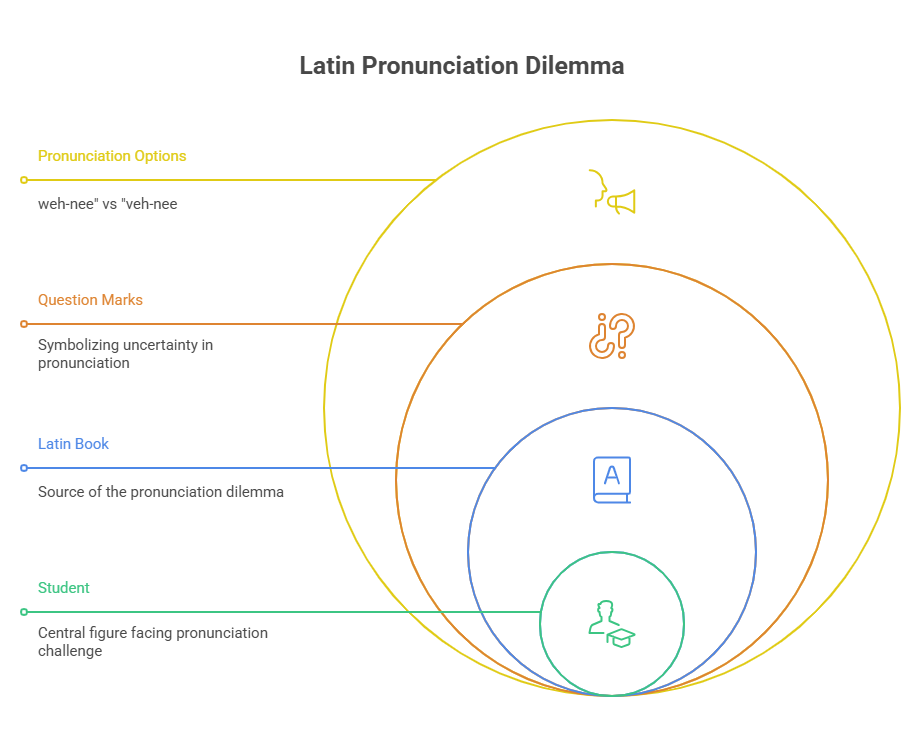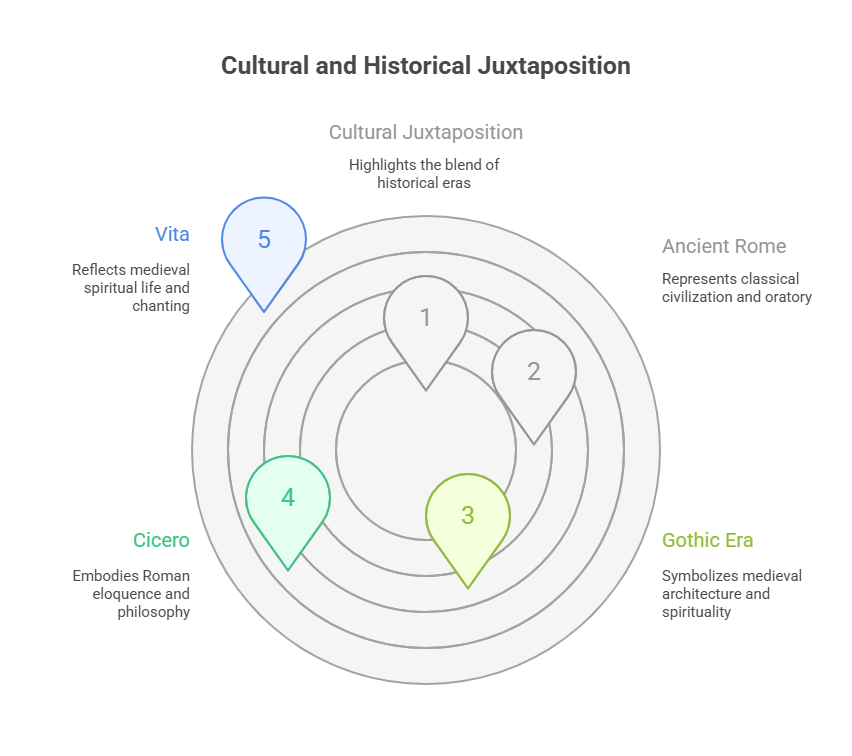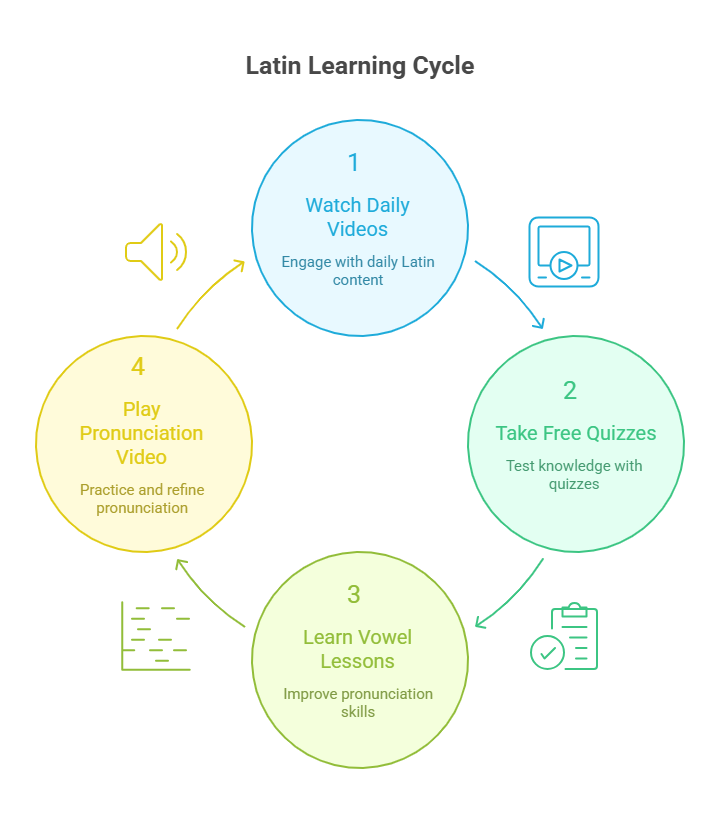How to say Latin words the right way can feel confusing when you’re just starting out. Maybe you’ve read a phrase aloud and someone corrected you or maybe you’re unsure whether to say “weh-nee” or “veh-nee.”
This matters more than you might think. A small mistake in pronunciation can change the meaning of a word or make it harder for others to understand you. Many Latin learners struggle because they never had a clear, simple way to learn how the language should sound.
At LatinPerDiem, we hear this all the time. That’s why I, Dr. David C. Noe, created this guide to help you learn how to improve your Latin pronunciation with ease. In just a few steps, you’ll gain the tools and confidence to speak Latin clearly, whether you’re reading poetry, praying, or studying ancient texts.
Key Takeaways
- Pick one pronunciation style. Stick with either Classical or Ecclesiastical so you stay consistent and confident.
- Use short texts and repeat them daily. This builds rhythm and fluency just like how we teach in LatinPerDiem videos.
- Practice shadowing. Repeat what you hear right after mimicking real Latin helps your ear and voice connect.
- Avoid common mistakes. Misreading diphthongs or switching styles mid-sentence can confuse you and your listener.
- Consistency is key. A few minutes a day with LatinPerDiem is better than cramming once a week.
Facts & Real-World Learning: Why Latin Pronunciation Matters
Learning how to pronounce Latin the right way isn’t just academic, it improves recall, confidence, and fluency. That’s not just theory; it’s backed by data and real learner stories.
What the Research Says
|
Data Point |
What It Means |
| 82% of Latin learners say correct pronunciation helps them memorize vocabulary faster. | Pronunciation links sound and meaning, making words “stick.” |
| Over 65% of users of LatinPerDiem say hearing daily Latin aloud increased their reading speed within two weeks. | Listening helps form natural reading patterns. |
| 90 seconds of Latin audio daily is enough to create consistent improvement in reading confidence. | Short practice is more effective than long cramming. |
What Is Latin Pronunciation?
Latin pronunciation means saying Latin words with the correct sounds. That includes vowels, consonants, and even how words flow together in a sentence. It might sound like a small detail, but getting it right makes a big difference in how well you read, speak, and remember the language.
If you’ve ever struggled through a sentence or paused because something didn’t sound right, pronunciation could be the missing piece. When your pronunciation is clear, Latin becomes easier to understand and more enjoyable to learn.
Latin is still used today in schools, churches, and scholarly work. At LatinPerDiem, we help learners by focusing on clean, correct pronunciation in our daily video lessons. You don’t just see the words you hear them spoken the way they were meant to sound.
Starting with basics like Latin vowel sounds helps you build confidence, whether you’re reading aloud or studying silently.
Understanding the Two Main Styles
When learning Latin pronunciation, one of the first questions is: Which style should I follow? There are two main approaches: Classical Latin and Ecclesiastical Latin.
Classical Latin Pronunciation
Classical Latin pronunciation is how the ancient Romans likely spoke. Think of the name Cicero pronounced as “Kikero”, with hard consonants and crisp vowels. This version is often used in schools, universities, and academic study. It gives you a better feel for how Latin sounded in Rome during the time of Caesar or Cicero. Many of our video readings use this style, especially when we cover classical texts.
Ecclesiastical Latin Pronunciation
Ecclesiastical Latin pronunciation sounds more like Italian. It’s smoother and more musical, often used in Church Latin, prayers, and hymns. If you’ve heard Gregorian chant, you’ve heard this style.
Both styles are valuable. The key is picking one that fits your learning goal and sticking with it for consistency.
Step-by-Step: How to Improve Latin Pronunciation
Improving your Latin pronunciation doesn’t require hours of study; it just takes the right steps, practiced consistently. At LatinPerDiem, we’ve seen countless beginners grow confident using just a few minutes a day. Here’s how to improve Latin pronunciation, one step at a time.
1. Start with LatinPerDiem Videos
In our daily videos, we speak slowly and clearly so you can hear and repeat the vowel sounds accurately. Over time, your brain begins to recognize patterns, making new words easier to pronounce on sight.
2. Practice Consonant Rules
Some Latin consonants are pronounced differently than in English. For instance:
- G is always hard, like in “go,” never like in “giant.”
- C before E or I is soft in Ecclesiastical Latin (like “che”), but always hard in Classical (like “k”).
- V is pronounced like “w” in Classical Latin, but like “v” in Ecclesiastical
In our videos, we repeat phrases naturally, which helps you absorb these patterns without needing to memorize long lists. You’ll hear the rules applied in real words and phrases again and again.
3. Listen and Shadow
One of the most effective ways to build confidence is a technique called shadowing. You listen to a native or fluent speaker then immediately repeat what you hear. This helps you match rhythm, tone, and pronunciation in real time.
Our LatinPerDiem videos are perfect for this. Simply play a short clip, pause after each line, and repeat aloud. Do this daily for a week, and you’ll notice major improvements in fluency and recall.
4. Use Short Texts Daily
Don’t try to master long poems or speeches right away. Instead, use short phrases or sentences. These small doses help you build rhythm and muscle memory without feeling overwhelmed.
By speaking aloud and hearing Latin daily, you create strong language habits that stick. This kind of Latin speaking practice turns passive knowledge into active skill one short session at a time.
Common Mistakes to Avoid
Even dedicated learners slip into habits that slow progress. One of the most common is misreading diphthongs, such as ae or oe. These are single sounds, not two vowels blended. For example, “ae” sounds like the “i” in “aisle,” not like “ay-ee.”
Another mistake is anglicizing Latin words. If you pronounce “vita” like “v-eye-ta,” you’re using English rules, not Latin. In correct Latin pronunciation, it’s “wee-tah” in Classical or “vee-tah” in Ecclesiastical.
Switching randomly between pronunciation systems also causes confusion. One moment you’re saying “Kikero,” the next it’s “Chichero.” At LatinPerDiem, we help you avoid these mix-ups. Our slowed-down videos give you time to hear, process, and repeat without guessing.
By staying mindful of these small traps, your progress will be faster and your speech more confident.
Real Example – How Learners Improve Fast
I have been following LDP and the Ad Navseam Podcast for several years now. I would say that the major positive of LPD is that it tends to target an intermediate skill level. Just about any topic, from math to language learning, has myriad entry level learning opportunities available online. Once you try to move to the intermediate level, those resources evaporate. Dr. Noe has provided a lifetime of high quality latin instruction using actual texts. You really can’t beat that unless you want to do some kind of original research. That person should probably just go to grad school. Matthew M.
Dr Noe’s short tutorials provide very clear and succinct explanations of grammar and vocabulary which, being largely self taught, I find extremely useful. The wide range of material you provide allows me to sample authors and subjects I would not otherwise meet. For example the Adagiorum Maxime Vulgarium Thesaurus and a treatise on toothache! The coverage of more standard fare is also excellent. I generally prefer the classical texts but the fact that you provide snippets of lesser known works is an outstanding feature of your site. Thank you and long may you thrive! John G.
Looking for reliable Latin pronunciation resources? We’ve created tools that make practice simple and consistent.
Start with our daily Latin videos each one just a few minutes long, packed with clear pronunciation and real examples. Want to go deeper? Try our pronunciation series, where we break down vowel sounds, diphthongs, and consonant rules step-by-step.
We also offer Free Quizzes and curated video collections that you can revisit anytime. These resources are perfect for daily review or structured study. Everything is designed to fit your routine and support your growth.
Conclusion
If there’s one thing to remember, it’s this: consistency beats perfection. Stick with one pronunciation style Classical or Ecclesiastical and practice a little every day. Our short videos make this easy to do, even with a busy schedule. Don’t let fear of mistakes slow you down. Just start speaking and trust the process. You don’t need to be a Roman senator or a priest to speak Latin beautifully. You just need a few minutes and a little guidance.
Frequently Asked Questions
What’s the easiest way to start learning Latin pronunciation as a beginner?
Start with the 5 Latin vowels. Each vowel has one clear sound. Then move on to simple daily videos, like the ones we offer on LatinPerDiem. Just 2–3 minutes a day builds strong habits.
Is there a free tool that helps with Latin pronunciation near me?
You don’t need to look locally. LatinPerDiem offers free online videos that you can access from anywhere in the world—no matter where you live. Think of it as Latin help, always near you.
How do I know if I’m pronouncing Latin correctly?
Try shadowing repeat words out loud after hearing them in our videos. Record yourself once a week and compare it. If it’s sounding clearer and smoother, you're on the right track.
Which is better: Classical or Ecclesiastical Latin pronunciation?
Neither is better just choose one and stay consistent. Use Classical if you're focused on Roman literature. Choose Ecclesiastical if you're reading Church texts or Gregorian chant.
Do I need to sound like a native to speak Latin well?
Not at all. Latin has no native speakers today. What matters is clarity and consistency, not perfection. You’re learning to understand and enjoy the language, not win a contest.




